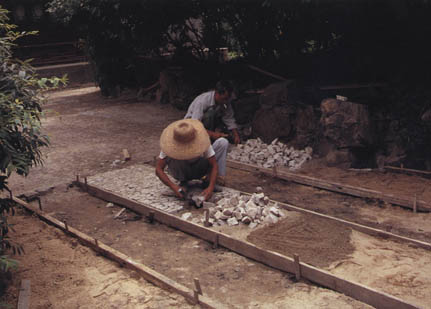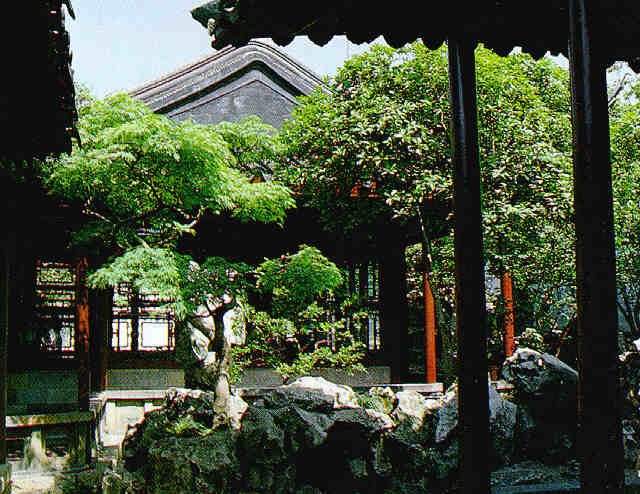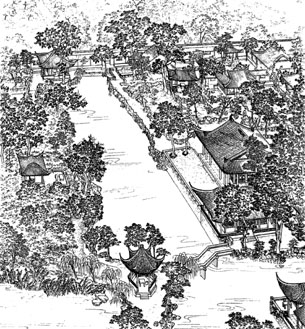
Xie Huan, Elegant Gathering in the Apricot Garden
Garden design was an art in China. One of the most common ways to make a Chinese home more elegant was to develop one or more compounds into a garden with plants, rocks, and garden buildings. Gardens were especially appreciated for their great beauty and naturalness. In time, garden design came to be regarded as a refined activity for the well-heeled and well-educated.
It may be useful to note that what we are calling a garden in China is somewhat different from its counterpart in western Europe or the United States. It is not an expanse of green with incidental buildings, but rather an area in which buildings surround arrangements of rocks, plants and water; without these buildings, the Chinese garden is not a garden. The architectural elements themselves are decorative and structure how one views the scenery. Good views are many and intimate in scale, in contrast with the sweeping vistas and mathematically ordered plantings of European gardens of the same period. The enclosure of the entire compound by walls or other natural barriers marks this area off as a special precinct for private enjoyment.
Gardens were an important part of the homes of the elite long before Ming times, but reached their fullest development in the late Ming in the Jiangnan area, which comprised the southeastern part of China south of the Yangtze River, including the densely-populated cultural centers of Yangzhou, Hangzhou, and Suzhou. These gardens served multiple purposes for their owners. They were extensions and developments of a family's property; they added cultural value by providing a pleasurable environment for private relaxation and entertaining friends and colleagues. In some cases they also contained a productive agricultural portion in the form of orchards or fields for cash crops that could support the needs of a large extended family. But most gardens were luxury items that demonstrated and enhanced the status of their owners.
As you look at the images in this section, keep in mind the following questions:
How does the garden relate to the courtyard-style home in terms of structure and design?
What differences between the house and garden made the garden a desirable addition to the elegant home?
What types of activities or events were more likely to take place in the garden as opposed to the house, and why?
How did the ways to make homes more elegant and impressive differ in China and Europe?
The movement of wealthy families of elite status to the Jiangnan region, which began during the Song dynasty and continued into the Ming, had an impact on the popularity of private gardens. Jiangnan was an area where things grew easily, aided by mild winters with plenty of rainfall. As these wealthy families shifted to urban areas, they established urban estates as their primary residences. Members of the literati and merchant classes who had the means and ambition to do so created intimate urban gardens within their household compounds as microcosmic replicas of nature. The gardens of Yangzhou and Suzhou in particular became famous. Tradesmen in turn responded to the demand, and these cities became centers for garden design, construction, and the distribution of the basic materials required to build a garden, such as flowering plants and shrubs and garden rocks.

Building a garden gave a person the opportunity to demonstrate his knowledge and cultivated taste. Even the most experienced and talented carpenter was not presumed to understand the philosophical principles needed to create a coherent design.
The designer, ideally the patron himself, had to master such diverse fields as siting (fengshui), architecture, water management, botany, and landscape design, as well as be familiar with the poetic and painted gardens and parks of the past.
Move on to information about fengshui if you have not already viewed it.

Wang Tingyun (1151-1202 AD), Secluded Bamboo and Withered Tree
Designing a garden was seen as an intellectual pursuit, and often took a lifetime to perfect. The garden was an unfinished work constantly under revision and improvement. In its aesthetic goals and the symbolism employed, it was closely linked to activities such as Chinese painting.
To an individual of cultivated tastes, the scholars' gardens of the Ming represented a culmination of many values expressed in other art forms like painting, calligraphy, and poetry. Landscape painting in particular was very influential on garden design.
The aesthetic goals of a Chinese garden were not the same as those in typical Western gardens. Compare below two views of the same garden, the Garden of the Artless Official, located in Suzhou, Jiangsu province.
What seem to be the dominant elements or most distinctive features?
Are these different from parks or gardens with which you are more familiar?


The personality of the garden's designer determined to a large extent the types of buildings, plants, and other features that were selected. The exterior environment might also influence how rustic or elegant a garden was in its architecture and decorative details.
Compare the Treebark pavilion (above) with the view through this gate in a city garden.
How do they each take advantage of the natural surroundings?
Another preference in garden design is to use shapes that metaphorically refer to elements in nature; some of the subtlest examples of this practice are also the most highly appreciated. The wall opening, above, is one example of an allusion to nature.
What might be some reasons for undulating walkways or walls in a garden like the one on the right?

ความคิดเห็น